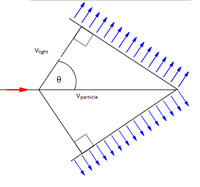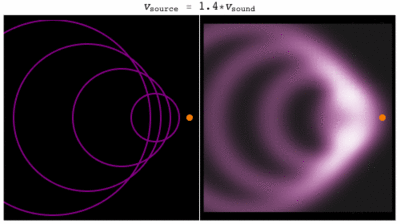Cherenkov Radiation: Difference between revisions
No edit summary |
|||
| (49 intermediate revisions by 2 users not shown) | |||
| Line 1: | Line 1: | ||
Claimed by Nikhil Shukla (nshukla30) | |||
Cherenkov radiation, named for Soviet Scientist Pavel A. Cherenkov, is a fascinating phenomena that occurs when charges move faster than light through | Cherenkov radiation, named for Soviet Scientist Pavel A. Cherenkov, is a fascinating phenomena that occurs when charges move faster than light through a particular medium. One commonly recognized example of Cherenkov radiation is in nuclear reactors which have a characteristic blue glow as a result [http://www.britannica.com/science/Cherenkov-radiation]. | ||
==The Main Idea== | ==The Main Idea== | ||
The | Cherenkov Radiation is analogous to a "sonic-boom of light". There are two vital parts to Cherenkov Radiation. The first is a dielectric medium and the second is a a charged particle moving faster than the phase- velocity of light. A dielectric medium is simply a medium that is an insulator but can be polarized by an external electric field [http://hyperphysics.phy-astr.gsu.edu/hbase/electric/dielec.html] . Since ''c'', the speed of light, is commonly accepted to be the universal speed limit it seems counter-intuitive to think that any particle can move faster than light. It is important to understand, however, that light travels slower through different mediums [http://www.physlink.com/Education/AskExperts/ae509.cfm] (i.e. water, glass, etc.) The reason behind this dives into Quantum Electrodynamics (Feynman has a great book on this) but can also be pseudo-explained using classical theories. | ||
The second important concept is the phase velocity of light. This refers to a individual portion of light and not the entire pulse. Think, for example, of a caterpillar. Each section of the caterpillar moves faster than the caterpillar moves horizontally. This phase velocity needs to be exceeded and there's no reason a charged particle can't move faster than the phase velocity. In fact, X-rays through a glass medium regularly exceed the phase-velocity of light[http://physics.stackexchange.com/questions/6912/in-superluminal-phase-velocities-what-is-it-that-is-traveling-faster-than-light]. | |||
Now we move into the explanation of Cherenkov radiation. When a charged particle moves through a dielectric medium it disturbs the electromagnetic field which results in electromagnetic waves radiating from the source. Think of a pebble being dropped in a pond and the 2D circle as the electromagnetic wave. Now the particle is actually moving so it is constantly interfering with the molecules around it resulting in more and more electromagentic waves. Since the particle is moving faster than the waves can propagate they start to collect in front of the particle building in intensity. Think of it like this... you drop a pebble in a lake and see the circle propagate. You time it perfectly and drop another pebble on that circle as it propagates. The two waves superimpose on one another to create an area of concentrated "circle" so to speak. Similarly a charged particle is continuously creating waves that are being superimposed on one another and move into the UV, Violet, and Blue spectrum of light. Thus we have Cherenkov radiation. | |||
The necessary velocity of the charged particle and frequency depend on the refractive index of the medium (dictates the phase velocity) and the periodicity of the medium[http://www.thphys.uni-heidelberg.de/~wolschin/eds14_3s.pdf]. | |||
==A Mathematical Model== | |||
=== Simple === | |||
Determining the phase velocity of light in the medium | |||
[[File:geometry_Cerenkov.png|200px|right]] | |||
<math>{\vec{v}_{light} = {\frac{c}{n}}}</math> | |||
where c = speed of light in a vacuum and n = the refractive index of the medium | |||
From the diagram on the right it is apparent that | |||
<math>{cos(θ) = {\frac{\vec{v}_{light}}{\vec{v}_{particle}}}}</math> | |||
which after substitution becomes | |||
[[File:SonicBOOMMMM.gif|right|400px]] | |||
<math>{cos(θ) = {\frac{c}{{n}\vec{v}_{particle}}}}</math> | |||
=== Not Simple === | |||
Determining the frequency of the Cherenkov Radiation is a lot less easier. | |||
It is given by the Frank-Tamm formula which is: | |||
[[File:FTFormula.png|left|200px]] | |||
where ω is frequency, E is energy, v is particle speed, q is particle charge, and μ is permeability | |||
== | ===A Computational Model=== | ||
If anyone can make a script for sonicboom's please do. Ish is hard. | |||
==Connectedness== | ==Connectedness== | ||
#How is this topic connected to something that you are interested in? | #How is this topic connected to something that you are interested in? | ||
#How is it connected to your major? | #How is it connected to your major? | ||
#Industrial applications? | |||
Cherenkov | Cherenkov Radiation ties together a lot of concepts. Quantum Electrodynamics, Shock-Waves, EM waves, Nuclear physics, Beta Decay, etc. It's just generally pretty cool although it's not connected to Materials Science and Engineering at all. you may come across it as an NRE. Industrial applications are with neutrino detection and nuclear engineering. | ||
==History== | ==History== | ||
Not too much history involved. Cherenkov Radiation was predicted in the late 1800's by Oliver Heavside and discovered by Pavel Cherenkov in the mid 1900's after he saw a blue light in water subject to atomic bombardment. As a result he won a Nobel Prize in Physics with Ilya Frank and Igor Tamm who developed the concept in the framework of special relativity. [http://www.nobelprize.org/nobel_prizes/physics/laureates/1958/cerenkov-bio.html] | |||
== See also == | == See also == | ||
[http://www.physicsbook.gatech.edu/Richard_Phillips_Feynman Richard Phillips Feynman] | |||
[http://www.physicsbook.gatech.edu/Electromagnetic_Propagation Electromagnetic Radiation] | |||
===Further reading=== | ===Further reading=== | ||
[http://www.amazon.com/QED-Strange-Theory-Light-Matter/dp/0691024170 QED: The Strange Theory of Light and Matter] | |||
===External links=== | ===External links=== | ||
[https://www.youtube.com/watch?v=x4Ir6E4IG64 Fermi Lab Youtube Video] | |||
==References== | ==References== | ||
http://www.britannica.com/science/Cherenkov-radiation | |||
http:// | [[Category:Radiation]] | ||
[[ | |||
#[http://www.britannica.com/science/Cherenkov-radiation Encyclopedia Britannica] | |||
#[http://hyperphysics.phy-astr.gsu.edu/hbase/electric/dielec.html Hyperphysics GSU] | |||
#[http://www.physlink.com/Education/AskExperts/ae509.cfm Physics Link Experts] | |||
#[http://physics.stackexchange.com/questions/6912/in-superluminal-phase-velocities-what-is-it-that-is-traveling-faster-than-light Stack Exchange] | |||
#[http://www.thphys.uni-heidelberg.de/~wolschin/eds14_3s.pdf University of Heidelberg] | |||
#[http://www.nobelprize.org/nobel_prizes/physics/laureates/1958/cerenkov-bio.html Nobel Prize] | |||
Latest revision as of 00:30, 3 December 2015
Claimed by Nikhil Shukla (nshukla30)
Cherenkov radiation, named for Soviet Scientist Pavel A. Cherenkov, is a fascinating phenomena that occurs when charges move faster than light through a particular medium. One commonly recognized example of Cherenkov radiation is in nuclear reactors which have a characteristic blue glow as a result [1].
The Main Idea
Cherenkov Radiation is analogous to a "sonic-boom of light". There are two vital parts to Cherenkov Radiation. The first is a dielectric medium and the second is a a charged particle moving faster than the phase- velocity of light. A dielectric medium is simply a medium that is an insulator but can be polarized by an external electric field [2] . Since c, the speed of light, is commonly accepted to be the universal speed limit it seems counter-intuitive to think that any particle can move faster than light. It is important to understand, however, that light travels slower through different mediums [3] (i.e. water, glass, etc.) The reason behind this dives into Quantum Electrodynamics (Feynman has a great book on this) but can also be pseudo-explained using classical theories.
The second important concept is the phase velocity of light. This refers to a individual portion of light and not the entire pulse. Think, for example, of a caterpillar. Each section of the caterpillar moves faster than the caterpillar moves horizontally. This phase velocity needs to be exceeded and there's no reason a charged particle can't move faster than the phase velocity. In fact, X-rays through a glass medium regularly exceed the phase-velocity of light[4].
Now we move into the explanation of Cherenkov radiation. When a charged particle moves through a dielectric medium it disturbs the electromagnetic field which results in electromagnetic waves radiating from the source. Think of a pebble being dropped in a pond and the 2D circle as the electromagnetic wave. Now the particle is actually moving so it is constantly interfering with the molecules around it resulting in more and more electromagentic waves. Since the particle is moving faster than the waves can propagate they start to collect in front of the particle building in intensity. Think of it like this... you drop a pebble in a lake and see the circle propagate. You time it perfectly and drop another pebble on that circle as it propagates. The two waves superimpose on one another to create an area of concentrated "circle" so to speak. Similarly a charged particle is continuously creating waves that are being superimposed on one another and move into the UV, Violet, and Blue spectrum of light. Thus we have Cherenkov radiation.
The necessary velocity of the charged particle and frequency depend on the refractive index of the medium (dictates the phase velocity) and the periodicity of the medium[5].
A Mathematical Model
Simple
Determining the phase velocity of light in the medium

[math]\displaystyle{ {\vec{v}_{light} = {\frac{c}{n}}} }[/math]
where c = speed of light in a vacuum and n = the refractive index of the medium
From the diagram on the right it is apparent that
[math]\displaystyle{ {cos(θ) = {\frac{\vec{v}_{light}}{\vec{v}_{particle}}}} }[/math]
which after substitution becomes

[math]\displaystyle{ {cos(θ) = {\frac{c}{{n}\vec{v}_{particle}}}} }[/math]
Not Simple
Determining the frequency of the Cherenkov Radiation is a lot less easier.
It is given by the Frank-Tamm formula which is:

where ω is frequency, E is energy, v is particle speed, q is particle charge, and μ is permeability
A Computational Model
If anyone can make a script for sonicboom's please do. Ish is hard.
Connectedness
- How is this topic connected to something that you are interested in?
- How is it connected to your major?
- Industrial applications?
Cherenkov Radiation ties together a lot of concepts. Quantum Electrodynamics, Shock-Waves, EM waves, Nuclear physics, Beta Decay, etc. It's just generally pretty cool although it's not connected to Materials Science and Engineering at all. you may come across it as an NRE. Industrial applications are with neutrino detection and nuclear engineering.
History
Not too much history involved. Cherenkov Radiation was predicted in the late 1800's by Oliver Heavside and discovered by Pavel Cherenkov in the mid 1900's after he saw a blue light in water subject to atomic bombardment. As a result he won a Nobel Prize in Physics with Ilya Frank and Igor Tamm who developed the concept in the framework of special relativity. [6]
See also
Richard Phillips Feynman Electromagnetic Radiation
Further reading
QED: The Strange Theory of Light and Matter